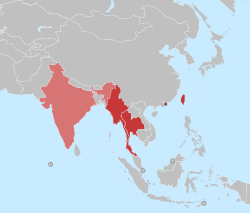Milk Tea Alliance facts for kids
Quick facts for kids Milk Tea Alliance |
|||||||||||||||||||
|---|---|---|---|---|---|---|---|---|---|---|---|---|---|---|---|---|---|---|---|

The "Milk Tea Alliance" flag created by netizens. The colours represent (from left) Thai milk tea, Hong Kong milk tea and Taiwanese milk tea.
|
|||||||||||||||||||
| Chinese name | |||||||||||||||||||
| Traditional Chinese | 奶茶聯盟 | ||||||||||||||||||
| Simplified Chinese | 奶茶联盟 | ||||||||||||||||||
|
|||||||||||||||||||
| Burmese name | |||||||||||||||||||
| Burmese | နို့လက်ဖက်ရည်မဟာမိတ် | ||||||||||||||||||
| Thai name | |||||||||||||||||||
| Thai | พันธมิตรชานม | ||||||||||||||||||
| RTGS | Phanthamit Cha Nom | ||||||||||||||||||
The Milk Tea Alliance is an online movement for democracy and human rights. It is made up mostly of internet users, called netizens, from Hong Kong, Taiwan, Thailand, and Myanmar.
This movement began as an internet meme. It started because many Chinese internet users were spreading Chinese nationalism online. The Milk Tea Alliance has grown into a big international protest movement. It stands against governments that have too much power and supports democracy. Besides the main four countries, the movement is also strong in the Philippines, India, Malaysia, Indonesia, Belarus, and Iran.
The Diplomat magazine says the Milk Tea Alliance is a good alternative to ASEAN. Even though it is not a formal group, it helps people who want democracy. For example, in Myanmar, it helps young people understand the fight between protesters and the army.
Contents
What's in a Name?
Milk tea is a very popular drink in Hong Kong, Taiwan, and Thailand. These were the first three places involved in the movement. Internet users from Myanmar and India also joined later. They also enjoy their own kinds of tea with milk.
Taiwanese bubble tea, Hong Kong-style milk tea, Thai tea, and Burmese milk tea are all similar. They are local versions of milk tea.
How the Milk Tea Alliance Started
The Beginning of the Movement
In April 2020, during the 2019–2020 Hong Kong protests, a Thai actor named Vachirawit Chivaaree posted something online. He is known as "Bright" and starred in a popular Thai TV show called 2gether. He shared an image on Twitter that called Hong Kong a "country." Hong Kong is actually a special administrative region of China.
This made many Chinese internet users angry. They attacked Bright online and called for people to stop watching his show. Bright later said sorry and took down the image. But Thai internet users defended him on social media. Their support for Bright turned into criticism of China. They started a "Twitter war" using the hashtag #nnevvy.
Chinese internet users then attacked Thailand's King Vajiralongkorn and Prime Minister Prayut Chan-o-cha. However, this did not work as planned. Many Thai people were already critical of their own government. Some even encouraged the insults. The Chinese embassy in Bangkok posted a long message on Facebook. It condemned the online criticism. A big online fight then happened between Thai internet users and the Chinese embassy.
In Thailand, support for Hong Kong and Taiwan grew. Their fight against China's influence brought together different groups of pro-democracy protesters. Being against Beijing became part of their platform against too much government power. Twitter users in Taiwan and Hong Kong soon joined the Thai users. The Telegraph newspaper called this "a rare moment of regional solidarity." In July 2020, Pallabi Munsi wrote in OZY that the Milk Tea Alliance was "Asia's volunteer army rising against China's internet trolls."
How the Alliance Grew
In the months that followed, the Milk Tea Alliance changed. It went from being just an anti-Beijing meme to a "leaderless protest movement." This movement pushed for change across Southeast Asia.
After the 2020 China–India skirmishes, India also became part of the Alliance. Masala chai, a spiced milk tea, became its symbol. Politicians in Taiwan and India have talked about the Milk Tea Alliance. For example, Taiwan's representative to the US, Hsiao Bi-khim, used the hashtag in a tweet. She thanked Indians for their support.
Later, Australia asked for an investigation into how the World Health Organization handled the COVID-19 pandemic. China then threatened to stop buying Australian products. This was to make Australia drop its demands. Internet users then included Australia in the Milk Tea Alliance. However, the connection to milk tea was not as strong. The milk product Aptamil was used as a symbol instead of a type of milk tea.
In August 2020, new pro-democracy protests started in Thailand. These were the biggest protests since the 2014 military coup. People in Taiwan and Hong Kong showed their support. This included activist Joshua Wong. The hashtag #MilkTeaAlliance was used a lot by the protesters.
The 2020 Belarusian protests also began in August. This happened after people rejected the results of the presidential election. Activists in Belarus were inspired by the Milk Tea Alliance. They started using Ryazhenka as a symbol of their resistance. Ryazhenka is a traditional fermented milk drink from Belarus, Russia, and Ukraine.
In February 2021, a military coup happened in Myanmar. Activists there and in Thailand started using the Milk Tea Alliance idea to show support. Pictures of Royal Myanmar Tea bags were shared thousands of times. A drawing by Thai artist Sina Wittayawiroj became very popular. It showed Thai, Taiwanese, Hong Kong, Indian, and Burmese milk tea under the "Milk Tea Alliance" headline. Protesters against the coup quickly joined this online movement.
In April 2021, Twitter created an emoji to support the Milk Tea Alliance. This was after anti-Beijing protests in Hong Kong and the 2021 Myanmar coup. It marked the one-year anniversary of the Milk Tea Alliance.
How the Alliance Works
The Milk Tea Alliance does not have a formal leader or a strict organization. It is a movement that works through many people online.
Images for kids
See also
 In Spanish: Milk Tea Alliance para niños
In Spanish: Milk Tea Alliance para niños



